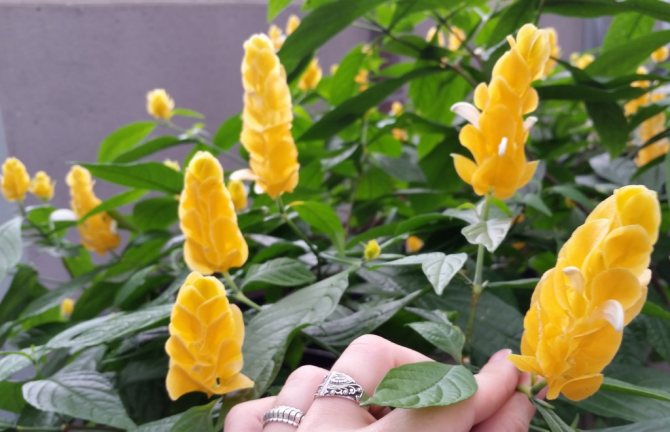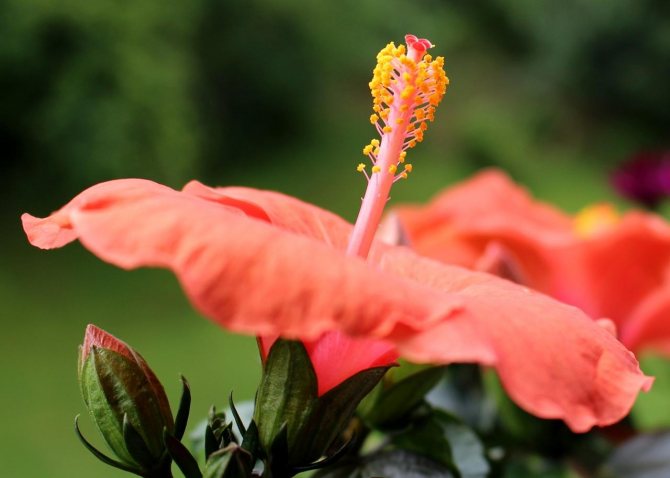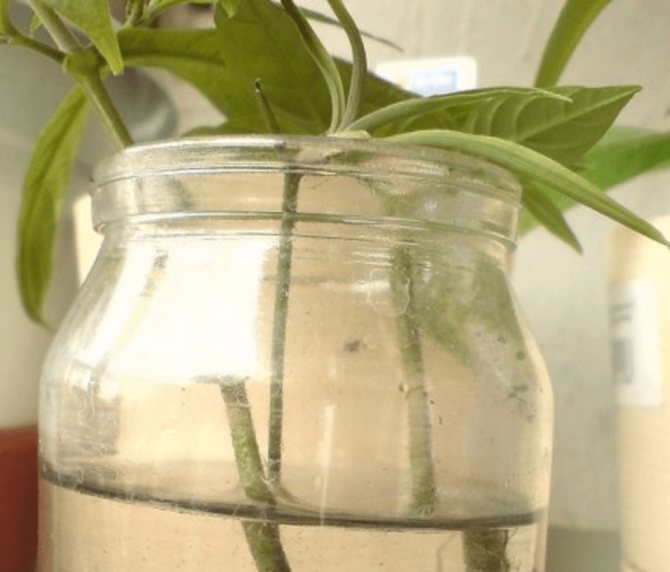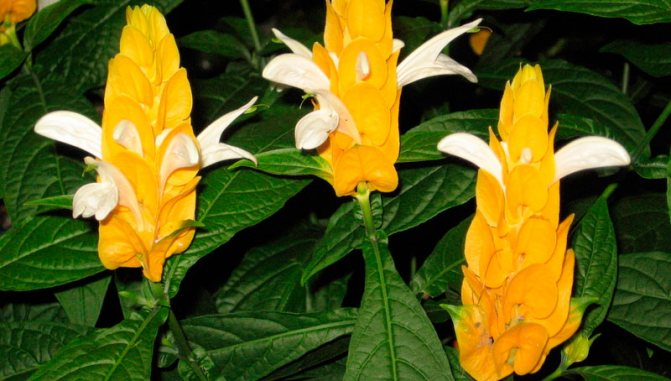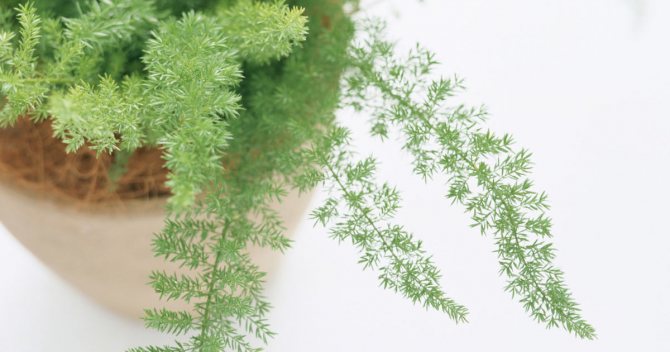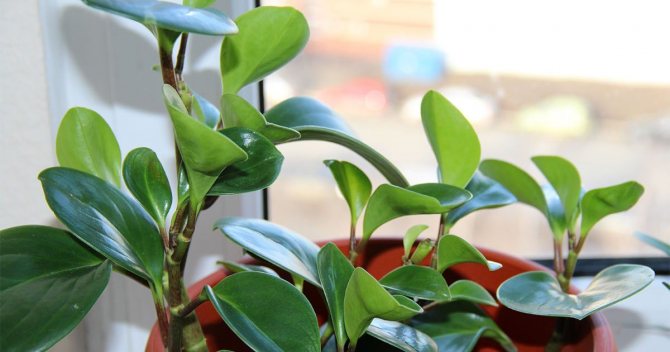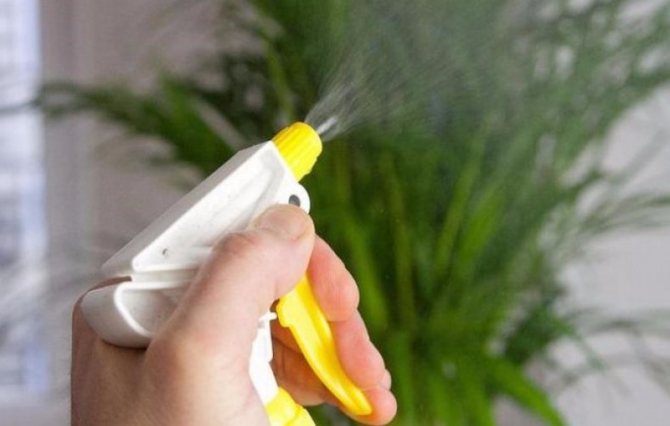Pachistachis is a genus of evergreen plants belonging to the Acanthus family and numbering about 12 species. However, only 2 members of the genus are suitable for indoor cultivation. Pachystachis Yellow is a shrub with a bright spike-shaped bracts, which is mistaken for flowers, deservedly belongs to flowering pot crops.
Pachistachis is a delicate and demanding ornamental culture that is difficult to grow at home. Therefore, due to its wayward nature, the tropical guest is not popular with domestic florists. However, if all basic recommendations are followed, you can get a healthy and beautiful shrub that will delight you with its flowering for a long time.
Reproduction and transplantation of pachistachis
First bloom.
Pachistachis reproduces very simply, I would say, even elementary. Unlike the opinion of "academic sources", who will never tire of copying articles from books about indoor floriculture and from each other, and who advise to propagate it by cuttings in the spring, I propagate it all summer. Moreover, a stalk planted in June blooms by the end of July, and I already take a stalk from it. The result is one hundred percent! And this is done like this: after the plant has bloomed (white flowers have fallen off), I cut the stalk so that at least two pairs of leaves remain on it, and after the bottom pair, 2-2.5 cm of the stem, then I roll the tip of the stem in Kornevin "(This is a very good analogue of" Heteroauxin ") and put it in a container with soil almost up to the leaves. It is better to make the soil for pachistachis not very heavy and rather loose, for example, "academic" - equally sod land, leafy earth, humus, peat, sand (I replace sand with perlite, it can be half as much). A container with a handle can (and better) be placed under a transparent cap (greenhouse, jar, etc.) in a bright place, and that's it. The spikelet that remains on the stem does not need to be touched, it will dry out and fall off by itself. During the rooting process, the lower pair of leaves will most likely die off, but when the young flower begins to grow new leaves at the top of the stem, you can get it out from under the cap and wait, after two to three weeks it will give the first flowers. And even if you are not going to breed it, I still advise you to do so. There are several reasons for this. First, it is better to plant three or four bushes in one pot at once, with correct and timely pinching, you can get 20 or more spikelets at the same time! Second, if you transplant pachistachis as the academicians recommend "young plants once a year, and old plants once every three to four years" with which I cannot disagree, then sooner or later you will suddenly find that you have become the happy owner of a plant with a long bare trunk and branches. Of course, this may be original, but not beautiful. Therefore, it is impractical to keep it for more than three years, and it is necessary to update it. But if you transplant it, you need to keep in mind that the roots of pachistachis love space, therefore the pot should be spacious enough (preferably 2.5 liters), and wide, but not high, is better. Drainage should be good, not less than 1-1.5 cm of fine expanded clay or clay shards. After transplanting, do some trimming of the stems.
Tell your friends about the article and the site. Just press the buttons ...
Thank you!!!
Reproduction methods
Pachystachis can be propagated by cuttings or seeds.
Cuttings
You can use cuttings 10-15 cm long, which remained after pruning the bush in the spring. Place them to root in water or in a peat-sand mixture. It is important to remember that when rooting in water, the plant often does not survive and rots. It is better to plant the cuttings in pots about 13 cm in diameter with a moist substrate to a depth of 1-1.5 cm. Pre-treat them with Kornevin. Cover with a plastic bottle or glass jar. After about a month, the cuttings will take root.
The cover can be removed when the first pair of new leaves appear. The plant must be accustomed to its natural environment gradually. First, the shelter is removed for 1 hour, after 2 weeks it is removed for good.
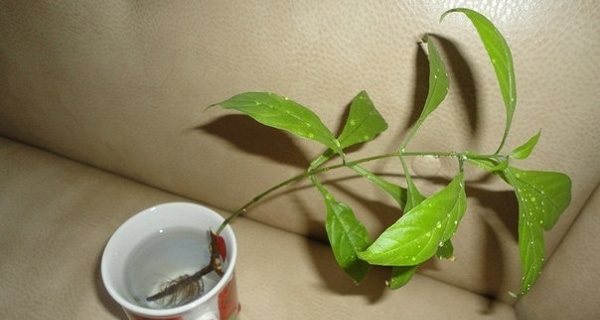
Seeds
This is a longer propagation method than cuttings. It is better to buy ready-made seeds in the store. Prepare a container with drainage holes. Fill it with loose soil. Make shallow grooves and sow seeds. Cover with foil on top, create a greenhouse. Periodic it is removed to ventilate and moisturize the substrate. When shoots appear, the shelter is gradually removed. Seedlings are transplanted into separate pots after 1-2 pairs of leaves appear.
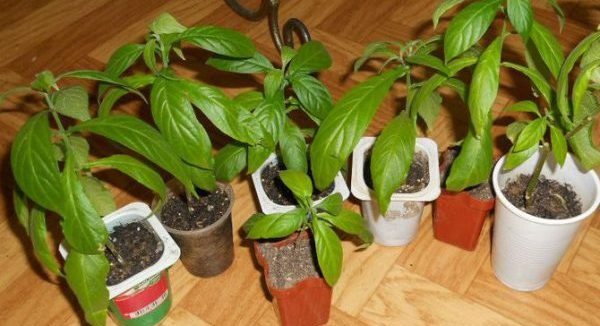

Care of yellow pachystachis
Fatshedera home care and transplant
Caring for him is very simple, you hardly need to look after him. The only condition that distinguishes it from the cultivation of other plants is high air humidity, the need to form a crown. Most often, plants are grown for up to two years, after which their trunk becomes stiff and they lose their decorative effect.
Lighting
An important condition is the abundance of sunlight, but such lighting should be scattered, because direct sunlight causes leaf burns, if it is too shaded, they become smaller, become longer, curl. Pachistachis grows well in the southwestern window, on the southeastern windowsill. If you decide to put a flower pot on the south side, then you should definitely shade it. And in the winter months, when there is not enough light for it to provide proper care, additional lighting should be organized.
Temperature
The optimal temperature regime for plants in summer, autumn, spring is 20 degrees Celsius, in winter months the temperature can be reduced to 16 degrees Celsius. If the temperature is higher than 24 degrees, then you should additionally spray next to the leaves. The flower does not like hot air, so it should be moved away from the battery. Caring for the plant also consists in eliminating drafts in the room.
Watering the plant
The flower loves abundant watering during the period of active growth. To understand whether or not to water the plants, it is enough to touch the soil with your hand and see how dry it is. If the soil dries out strongly, you need to water it every day. If the plants are poorly watered, care little, then the leaves curl, fall off and then a long recovery process occurs. It is also not worth pouring over the flower, in order to avoid decay of the root system. In addition to watering, to moisturize the plants, it is necessary to constantly spray it. Only by spraying pachystachis leaves, they become dark emerald and shiny. In winter, when the radiators are working and the air humidity is low, the plant should be sprayed in the morning and evening. In order to artificially increase the humidity and create a microclimate, the pot is placed in a tray with wet expanded clay.


Fertilizer
Fertilize pachystachis yellow with a diluted mullein. For the solution, 1 part of mullein is taken to 10 parts of water, similarly you can use mineral-based fertilizers.The plants are fed every 14 days, after spilling the soil with plain water.
Plant pruning
To give a beautiful decorative look, it is necessary to shape the crown. Under natural conditions, pachistachis grows among perennial plants, tall shrubs. In order to get more sun rays, the plant quickly stretches up and branches little. Only when the growth reaches almost a meter does the branching process begin. In order for the flower to have a decorative look almost from the first days, it is necessary to trim and pinch. Therefore, already in the first year, it is necessary to form a crown.
They begin to cut it off after the bush reaches a growth of 10-15 centimeters. From those shoots that develop in dormant buds, the third pair of leaves is removed. The same procedure is repeated for each layer of the plant. These manipulations are performed three times in the first 12 months, then in the winter months you can get a shrub with 12 tops. Do not forget about pinching the tops in such a way that there are two branches on each of the tops that have passed the pruning process.
Such a plant can already bloom on its own without pruning. After flowering, each dying inflorescence will begin to branch into two shoots, which subsequently will also give bright yellow inflorescences. The shrub will take on a decorative, beautiful appearance with flowers that look like yellow candles. The pinching is repeated annually.
Pachistachis transplant
Due to the fact that pachistachis grows rapidly and stretches upward, it must be transplanted every year. It is preferable to do this after cutting the crown. For transplanting, a soil containing clay, turf, leafy soil, humus, peat, river sand is suitable; you can supplement the mixture with charcoal. Previously, a drainage layer based on expanded clay or other material is laid out in the pot.
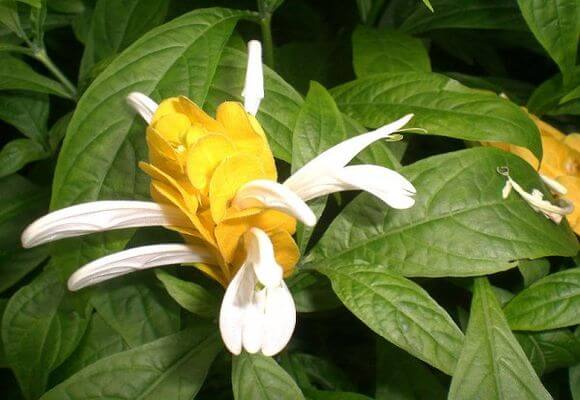

Diseases and pests of indoor flower
The capricious pachistachis painfully reacts to some mistakes of the grower in the process of caring for him:
- Lack of moisture in the soil can lead to yellowing and further leaf fall. Establishing an irrigation system and frequent spraying of the flower can solve the problem. However, it should be borne in mind that after complete exposure, the bush is restored for a rather long time.
- The dried edges of the leaves indicate that the plant is kept in a room with a dry microclimate. A container with water nearby and regular spraying will be able to return the decorative effect to the bush.
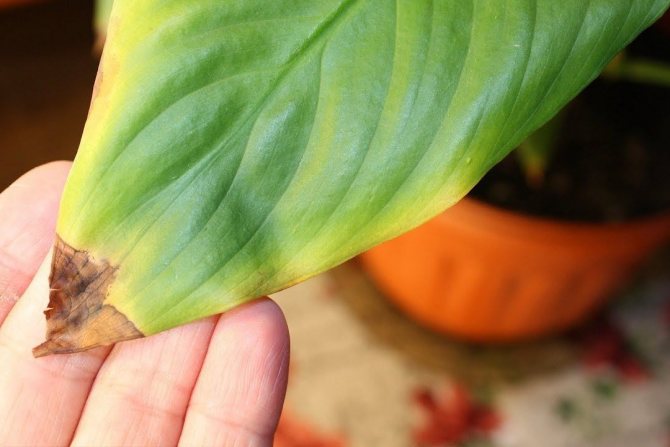

Dried leaf tips - Keeping the flower in a cold room during the dormant period will result in shedding of foliage. It is enough to raise the air temperature in the room with the bush to 20 ° C to stop the process of its exposure.
- Twisted sheet plates are a consequence of a lack of light. Artificial lighting or moving the decorative culture to a brighter place will stop the process.
- The slow growth of the bush and the lack of flowering indicate that the pachistachis lacks nutrients. Regular fertilization during the active growing season will always maintain a sufficient amount of nutrients in the soil.
- Excessive watering and sudden changes in temperature can lead to decay of the root system of the flower. The plant can only be saved by removing rotten roots and transplanting it into new soil.
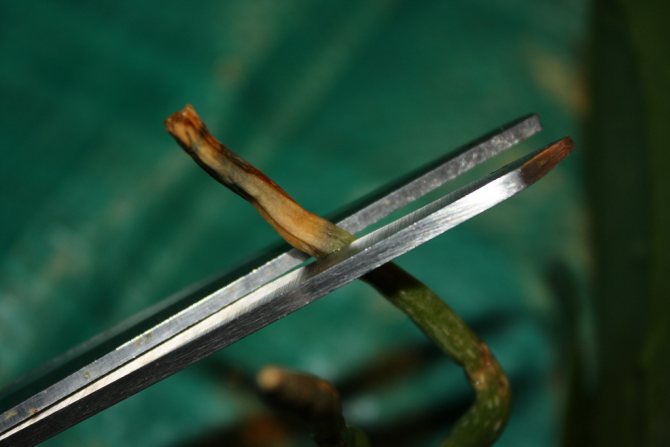

Removing roots - Pachystachis can also be affected by various harmful insects, namely aphids, spider mites, mealybugs, scale insects and whiteflies. These parasites suck the juices out of the plant and disrupt its life cycle. Untimely treatment or lack of measures causes the death of the flower. Treating the bush with systemic insecticides will destroy aphids, worms, scale insects and whiteflies. Against spider mites, acaricide or insectoacaricide will be an effective remedy.
Transplant, feeding, reproduction of pachistachis
Amaryllis home care


Insofar as pachistachis - actively flowering plant
(and if you create the right conditions for him in winter - something that blooms constantly), it
needs intensive feeding
... Pachistachis should be fertilized at least twice a month with mineral fertilizers or fertilizers for flowering plants (you can alternate) during the period of active flowering of the plant. In winter, if your pachistachis does not bloom, the frequency of feeding can be reduced to once a month.
Pachystachis grows fast enough
, in addition, with proper pruning and care, the pachistachis bush can reach impressive sizes. In this regard, pachistachis is a plant that is suitable for placement on a windowsill (small specimens), and for placement on the floor, in the event that the pachistachis has grown to a significant size. Pachystachis should be transplanted as it grows, usually in the spring, before flowering. The soil for replanting should be chosen loose and light; many growers advise mixing an earthen mixture with crushed charcoal, which will protect the roots from decay. When choosing a pot, preference should be given to wide, but not too deep containers.
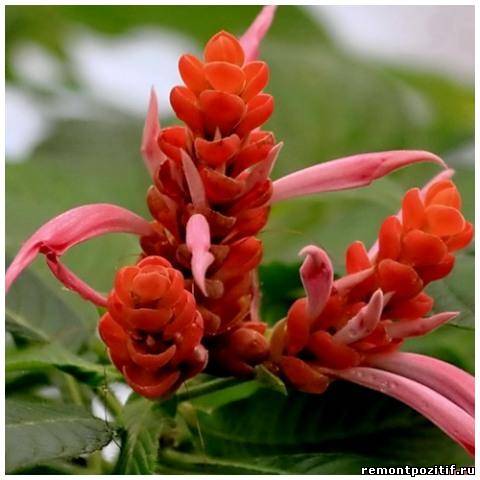

The most convenient and frequently used breeding method of pachistachis - cuttings
... A pachystachis stalk, at least 8-10 cm long (you can take either a flowering stalk or not - there is no consensus among flower growers on this matter, some argue that a flowering stalk is required for good rooting), are rooted in a moist, loose substrate ( or a glass of water). At the same time, for good rooting, the creation of greenhouse conditions will be required. For this, the stalk should be covered with a plastic bag, which should be removed daily to ventilate the plant, in addition, the rooted stalk should be well moistened, since the pachistachis loves moisture. Keep such a mini-greenhouse in a warm, well-lit place. After the roots appear, the cutting can be transplanted into a larger pot. In order for the plant to take root well in a new place and the acclimatization process proceeded favorably, after transplantation, pachystachis can be watered with a vermicompost solution. Also, speaking about the reproduction of pachistachis, it should be noted that you can take cuttings for planting from an adult plant all year round, so you can grow a new plant at any time, when you want. Today we met another guest from South America who feels very comfortable in our apartments - with pachistachis. This southern plant with its original appearance can transform any interior - it looks equally good both as a floor decor and as a classic window decoration - in pots on the windowsill. In short, with pachistachis, you can choose where exactly in your apartment you will create a small corner of a tropical oasis.
Disease prevention
When grown properly, this flower rarely infects disease. However, if the inflorescences suddenly began to fall off, and the leaves began to curl, then something goes wrong and you should immediately come to the aid of the plant.
Stefanotis - home care
The flower may have been struck by a pest. It is necessary to protect the shrub from aphids, which can cause significant damage to the flower. Whitefly, mealybugs and spider mites can also be chosen by pachystachis. In this case, it is necessary to send the plant to quarantine, excluding the possibility of the spread of these insects to other plants.
Interesting! If the plant is not heavily affected by pests, then it will be enough to treat it with soapy water. If there are too many insects, then insecticides cannot be dispensed with.
Why do the leaves turn yellow and curl
Sometimes pachistakhis, treated kindly with attention, and taking care of it at home like clockwork, begins to hurt.There may be several reasons, in addition to the attack of harmful insects.
For example, why do pachistachis leaves curl? An experienced florist knows that this phenomenon can be due to dry air. In this case, it is worth taking measures to moisturize it. Frequent spraying or moving shrubbery away from a room radiator will most likely correct the situation.
Why does pachistachis not bloom, but its stems are stretched out? The problem is insufficient sanctification. The situation can be easily corrected by moving the plant to a more lighted area and pruning the elongated stems.
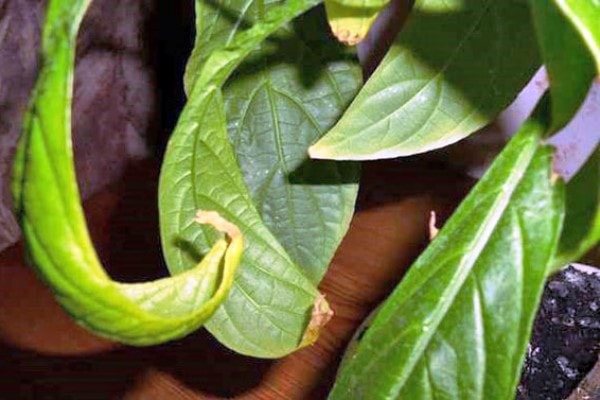

Pachistachis. Twisted leaves
Pachistachis. Home care
Zamioculcas home care, cultivation, reproduction and transplantation
Pachistachis how to care at home. Pachistachis: reproduction. Pachistachis: transplant. Pachistachis: cultivation. Conditions necessary for the cultivation of pachistachis.
PACHIS YELLOW (Pachystachys lutea)
Pachystachis yellow began to be grown as a houseplant relatively recently. It is similar to the more common beloperone guttata, or shrimp plant. Both of these plants belong to the Acanthus family. The bright yellow patistahis bracts grow vertically like candles on the tops of leaf-bearing stems - for which the plant was named Lollipop. Between the bracts are white, snapdragon-like flowers. When the flowering is over, the pachistachis can be kept simply as an ornamental leafy plant, although after flowering it must be cut in half so that it retains its compact shape, a healthy plant has dense bright leaves growing along the entire length of the stem. If they are pale, dull or drooping, the plant needs care and attention.
What conditions are necessary for growing pachistachis
Illumination: full solar illumination. In winter, shade the plant during the dormant period.
Temperature: The average temperature in summer is about 16 ° C, (maximum 21 ° C). In winter, the temperature should be lower, but not less than 7 ° C, otherwise the plant may temporarily lose its foliage.
Watering: In summer, keep the soil moist at all times by watering the plant 2-3 times a week, or even more often if the soil dries out quickly in hot weather. Water about once a week in winter. The soil should never completely dry out, but make sure that it does not become too wet. Never leave plant roots in water.
Air humidity: spray the plant 2-3 times a week; to increase the humidity, place the pot in a tray with wet pebbles or expanded clay.
Top dressing: During the growing season, apply liquid fertilizer for indoor plants once a week, diluted according to the manufacturer's instructions.
Soil: clay soil mixture. Provide good drainage.
Pachistachis transplant: annually, in early spring.
Transplant the 5 year old plant into a 13 cm pot. Place more shards, pebbles, or gravel on the bottom of the pot to ensure good drainage.
Appearance Care: Clean the dusty plant with a soft brush or feather duster. Don't use leaf polish.
Pachistachis. Care features
Pruning. When the flowers and bracts wither, cut the stems 7-15 cm from the soil surface. Cut the stems just above the topmost remaining leaf.
High humidity. To maintain a high level of humidity, place the pot in a drip tray with wet pebbles, but make sure the bottom of the pot does not touch the water. Do not spray the plant while the bracts are forming, or they will start to rot.
Types and varieties for growing at home
In indoor conditions, out of 12 species of pachistachis, only two have taken root.
Yellow (lutea)
Evergreen shrub about 1 m high. The lower part of the shoots lignifies over time. Leaves are oval in shape, 15-20 cm, tapering towards both ends.Clear streaks are visible on the surface. The inflorescences of the plant are yellow, located on a straight peduncle 10-15 cm long. The flowers bloom gradually - from the base to the top. Flowering lasts from early spring to mid-autumn.
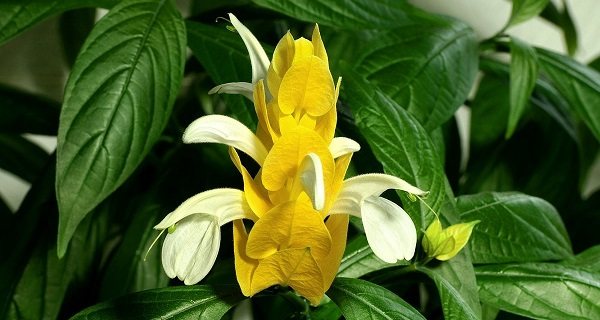

Red (coccinea)
A very rare species in home cultivation. The shrub grows up to 2 m. The decorativeness of the plant is given by bright red flowers with dark green bracts.


Array
Pachistachis care at home with video
Caring for pachystachis at home is quite simple to organize, since the plant is unpretentious, but it still requires regular pruning of shoots and high humidity. A biennial culture is the most rational. If the plant is grown for a longer period, then its lower part usually begins to bare, which causes a slight loss of decorative qualities.
Accommodation
Pachistachis is a light-loving plant, for which it is important to choose a place with bright diffused light. Do not allow direct sunlight to fall on this shrub.
Temperature. The room in which the pachistachis is located must be kept at a constant temperature (17–20 ° C). In winter, the plant needs cool conditions (at least 14 ° C).
Watering. In spring and summer, the shrub must be watered abundantly, and also sprayed with water at room temperature twice a day - in the morning and in the evening. In the fall, you need to gradually reduce watering. In winter, the frequency of watering depends on the speed of drying of the earthy coma. In this case, the air temperature should be about 12 ° C. Spraying can be done once a week. If the air is too dry, the plant should be sprayed more often, otherwise the tips of the leaves will turn yellow. In the warm season, the leaves of the bush must be washed with water at least once every two weeks.
Top dressing. Top dressing with complex mineral fertilizers should be carried out once a week.
The soil. When planting, it is better to use a soil mixture consisting of two parts of leaf, two parts of peat, one part of humus soil and one part of sand. Good drainage from expanded clay or broken brick is required.
Pruning. In the spring, pruning of the branches of the shrub should be carried out. This will not only give it a beautiful shape, but also cleanse the plant of old branches and leaves.
Reproduction. The best way to propagate pachystachis is by cuttings. After pruning, there are many green cuttings that can be used as planting material. To do this, it is enough to plant them in warm, loose soil.
Pests and diseases. It is often affected by aphids, whiteflies, spider mites. When there is a lack of moisture, it drops leaves. Dry air is the main reason for the yellowing of the tips of the leaves.
See how pachystachis is taken care of at home: the video illustrates the main points of planting, watering, pruning and forming a shrub:
Description
A perennial plant, reaching a height of 1.5 m, forming a kind of spherical bush of thin stiff stems. The leaves are oval, elongated at the ends, 10-12 cm long, sinewy, dark green.
In late March - early April (and almost until October), at the ends of the processes, tightly adjacent to the stem, yellow or orange candles from the scales of the bracts appear from bottom to top. Then soft, about 10 cm long white, orange or pink flowers, in the form of elongated petals, two or four, depending on the species. After one to two weeks, the flowers wither, but the ear itself remains. During flowering, 15 or 20 flowers may appear on the bush.
Pachystachis care at home
Pachistachis is quite unpretentious, but you can get a beautiful, lush and long-flowering plant only if a number of requirements are met.
Lighting. Pachystachis needs bright diffused lighting, about 2600 - 3000 lux, and cannot stand direct sunlight, which leads to burns of soft leaves.When placed in a room, windows of the western or eastern directions are most suitable for him. On the south window, shading will be needed at midday, and on the north it will be too dark, because of which internodes will begin to stretch ugly, and flowering will be poor or not come. But if the choice is limited, the flower can be supported by lighting with special phytolamps, forming an artificial daylight hours with a duration of at least 10 hours.
Temperature. Moderate summer temperatures are preferred, ranging from 22 - 24 ° C, and cool winter contents at 16 - 18 ° C. If you do not provide a similar temperature regime, then the branches will very quickly lose their foliage and become bare. These effects can be expected in both hotter summers and colder winters. Going beyond the optimal values will not affect the general well-being of the plant, but the appearance will be greatly affected.
Watering. In spring and summer, watering is carried out abundantly, focusing on the condition of the soil: between waterings it should dry out by about a quarter. In winter, watering is significantly reduced, but they do not allow the earth to dry out completely.
For irrigation, use only soft, well-settled water that does not contain chlorine and lime.
Air humidity. For normal development, the plant requires a relatively high air humidity, about 60%. To achieve such indicators, on summer days, the crown of the bush must be regularly sprayed, preferably both in the morning and in the evening. In addition, a pot with a plant can be placed on a pallet with wet expanded clay or pebbles, or a container with water can be placed next to it.
In winter, with a cool content, you can limit yourself to the above measures, but if the pachistachis is in a warm room, then it is advisable to use more effective measures to increase the humidity, for example, a household steam generator or a humidifier.
The soil. Pachystachis is not particularly picky about the composition of the soil. The main conditions are that the soil should be slightly acidic, with a pH of 5.1 - 6.5, loose and nutritious. The planting mixture can be prepared independently, taking two parts of sod land and one part of leaf or peat land, humus and coarse-grained river sand. You can add more crushed pine bark, which will not only increase the air permeability of the soil, but also slightly acidify it.
In addition, any soil for flowering plants that has a slightly acidic reaction is suitable.
Top dressing. During the growing season, feeding is carried out every two weeks with specialized fertilizers for flowering plants. During rest, feeding is stopped.
Transfer. Young specimens are transplanted annually, in spring, and adults - every three to four years.
The pachistachis pot is selected quite spacious, a three-year-old plant needs a capacity of at least 2.5 liters. Before planting, a good drainage layer is formed at the bottom of the pot, preventing stagnation of water at the roots.
Pruning. When growing pachystachis at home, pruning becomes a necessary annual procedure. It not only increases the bushiness of the plant and forms its crown, but also helps to hide the quickly bare trunk, stimulating the growth of young leafy shoots.
Reproduction. The plant is easily propagated by apical semi-lignified cuttings. On cuttings in spring or summer, the upper part of a well-developed shoot is cut off, 2 - 3 internodes and an upper pair of leaves are left on it. The lower part of the prepared cutting is processed in heteroauxin or root, planted in a pot with a damp substrate and placed in a mini-greenhouse or simply covered with a transparent cap.
A rooted plant can bloom in the same year or next spring.
Diseases and pests. The main pests are aphids, whiteflies, mealybugs and spider mites. At the first signs of infection, pachistachis is treated with chemicals of the appropriate action, for example, Aktellik or Fitoverm.
The plant is practically not susceptible to diseases, but suffers due to violations in the conditions of detention. In particular, for various reasons, it very often loses leaves.
Soil composition
A breathable soil with a slightly acidic alkaline medium pH 5.1-6.5 is suitable, checked with a litmus indicator strip. On sale there is a soil for flowering indoor plants, which is ideal for pachystachis.
You can prepare the soil yourself, for this you will need:
- 1 part peat;
- 1 part sand;
- 2 pieces of garden land;
- A handful of chopped pine bark, the flavonoids of which will prevent the development of mold, the spread of insects.
Expanded clay or large pebbles must be laid at the bottom, which will prevent stagnation of water in the lower layers of the soil, provide good drainage and air permeability of the substrate.
The transplant is carried out annually for the first three years of growth, changing the volume of the flower pot to a larger one. It is enough to replant an adult plant every 3-5 years, but not less often, providing a constant change of nutrient soil. This is important for further active flowering, leaves shine. A three-year-old flower will need a soil volume of 2.5 liters, the former earthen lump will take 5/6 parts, so there will be room for loosening and watering, additional growth of the root system.
How to care for a yellow ear
Pachistachis grows best on the western and eastern windows. Here he receives sufficient illumination, being protected from direct sunlight. This flower is tropical, but it loves light and heat, so it is impossible to keep it cool. At temperatures below + 16 ° C, it begins to lose its leaves.
Pachystachis in nature
It is best to keep it at room temperature, which does not fall below + 12 ° C, while drafts and dry air are unacceptable during the heating season. This home exot is capricious to temperature extremes.
Pachistachis, which is quite simple to care for, loves moisture very much. This applies not only to watering, but also to the level of humidity around it. Drying out of the earthen coma is not allowed, but you should not make puddles in the pot either. Watering should be regular, abundant in the hot months, but more moderate, starting in the fall.
Experts recommend putting a special moisture indicator inside the pot, which will allow you to correctly determine whether the plant needs watering. This will make it much easier to grow and help create optimal conditions for the development of the tropical beauty. In the summer and during the heating season, it is necessary to carry out constant spraying from a spray bottle so that the air around does not dry out.
Transplant and renewal of pachistachis
The transplant is carried out every year with the arrival of spring. The soil for the plant should not be heavy, moisture-consuming, loose, always moist (but not wet, do not flood the plant). Special soils are on sale that are capable of absorbing water, like a sponge, but at the same time are porous, providing the roots with free access to oxygen.
Pachystachis yellow or red are characterized by rapid growth, so you should not postpone the formation. All weak shoots must be cut off in a timely manner, branches with leaves should be shortened by about a third. In this case, you get a lush and attractive bush that can reach a meter in height.
Where is it better to put?
there is several options for plant placement, in which it will bring good luck residents of the house:
- You can put a plant in the bedroom. This will make the relationship between lovers more harmonious and warm. Astrologers recommend choosing a species called the Heart of Kerry. In this species, even the leaves grow in the shape of a heart.
- If you put a flowerpot in the children's room, it will help your children grow more independent.
- Also, many growers put the plant in the living room or dining room. Hoya helps to get rid of fatigue and recuperate after a hard day's work.
Reference! Hoya can even be installed in your office. If you constantly look after her and do it correctly, she will thank her owner with success in her work. The most important thing is to provide the culture with maximum care.
To put a hoya in his home or not, everyone decides for himself. Undoubtedly, this plant has more positive properties than negative ones. The flower makes the air cleaner and saturates it with oxygen, and also fights against skin diseases and simply decorates the interior.
How to propagate pachistachis at home
For many who decide to grow house plants, the issue of their reproduction is important. Most novice flower growers know how to grow violets, but with exotic plants, successful results are not always obtained. Usually this procedure is simple, but for each type it has its own characteristics that must be followed exactly. Pachistachis, which is propagated by cuttings, is not so demanding. The procedure can be carried out at any time of the year, although it is better to do this in the spring during the formation of the crown.
Bract
Each stalk intended for rooting should have two internodes and leaves. It is better to start planting when the air temperature is not lower than + 20 ° C warm, and the humidity level is high. All cuttings are placed under glass jars, they are removed daily for a couple of hours for airing. On average, it takes two weeks to root, after which young plants can be transplanted into seedling pots.
Active flowering in a growing pet can be caused by a phased transfer to a large pot. Florists recommend planting several plants at once in one flowerpot to make the bush more lush.
What is needed for development?
The unusually attractive pachistachis are unpretentious, they easily take root in almost any conditions. Therefore, they are often used to decorate public spaces, offices, reception rooms. They grow well in an ordinary apartment, in winter gardens and on open terraces. In order for the plant to develop correctly, to be attractive, certain conditions of keeping must be observed:
- For cultivation, pachistachis prefers well-lit places, only in the summer it is necessary to create a slight shade to protect its leaves from burns.
- During the summer months when temperatures are high, it is necessary to spray frequently with a conventional spray bottle.
If you do not follow the rules of care, then the pachistachis flower can get sick:
- Even with small drafts, foliage begins to fall off. The same phenomenon is observed with a lack of watering. Therefore, if the crown of your flower has begun to thin out, check if the right conditions have been created for it.
- The tips of the leaves become dry and curled. The reason is that the air is too dry, it is necessary to spray, otherwise the exotic will stop blooming soon.
This indoor flower is beautiful and decorative, care for it is minimal, but you should not forget about due care.


